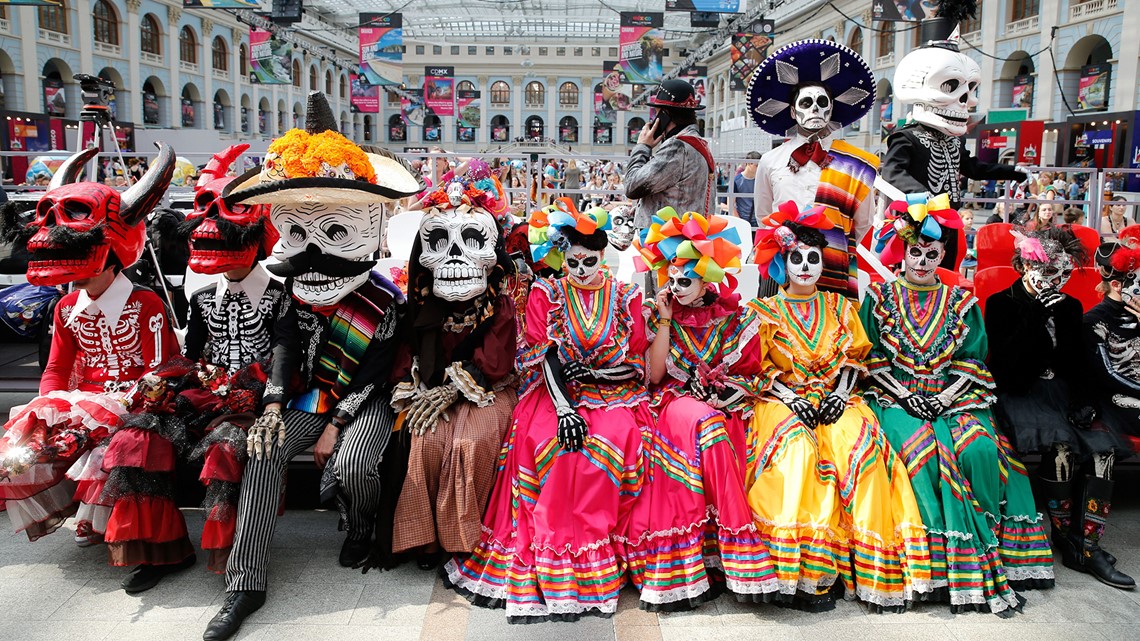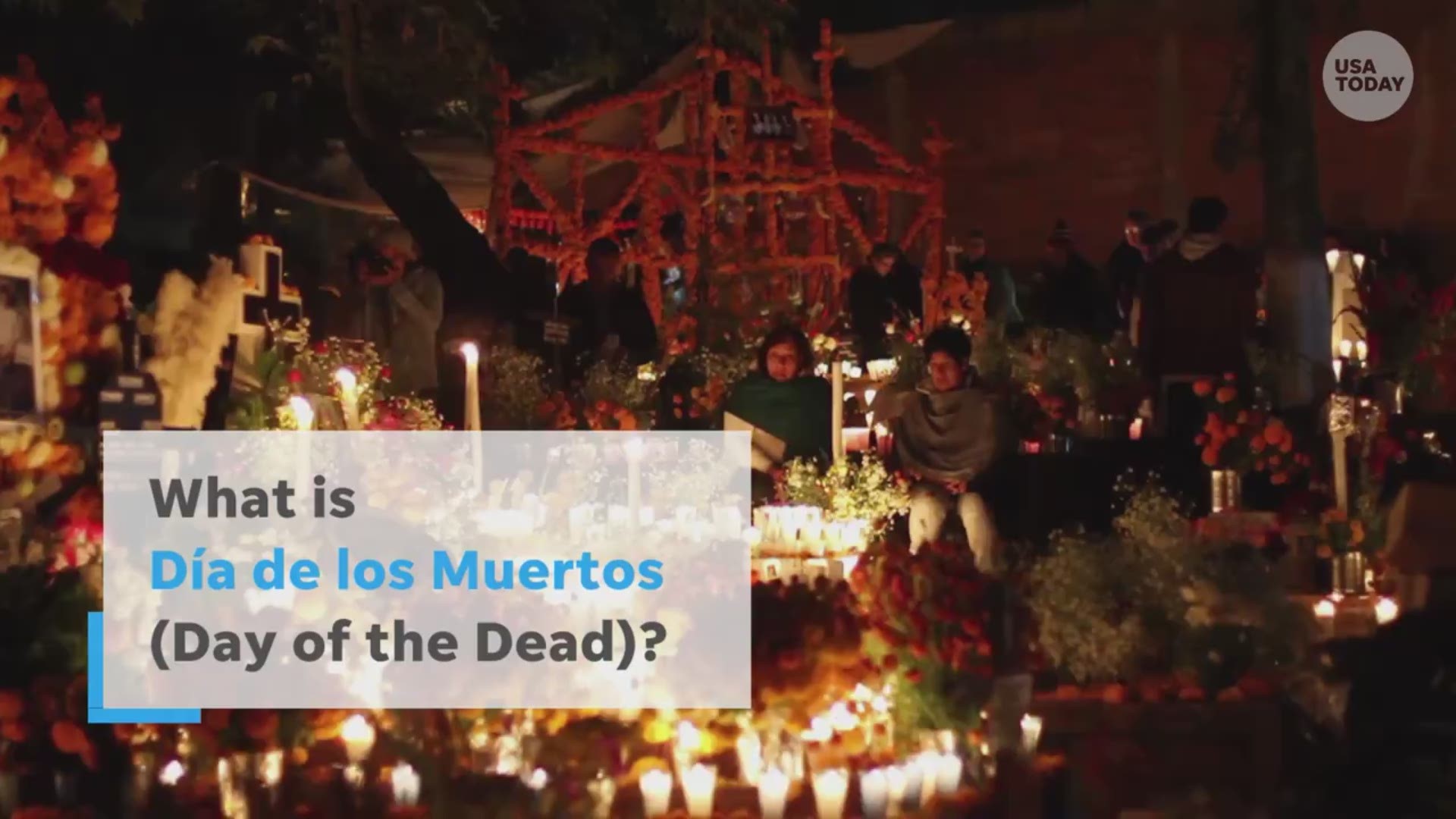About this time of the year, Chucho Rodriguez is working his fingers to the bone. His business as a tattoo artist in Lockport, Illinois, picks up in October.
Folks want skulls. Lots of skulls.
Increasingly, though, they want tats of the decorated sugar skulls adorned with flowers rather than those associated with pirates, haunting and Halloween.
That’s because of growing interest in Day of the Dead – or Dia de los Muertos – the Mexican holiday that celebrates the lives of deceased friends and family. These distinctive sugar skulls play a prominent role in the celebration.
“The skull with all of the decorations; you can almost consider it to be pop culture now,” said Rodriguez, a Mexican immigrant who has been commissioned to produce murals and sculptures throughout the Midwest.
Celebrated in the U.S. from Oct. 31 to Nov. 2, the holiday tradition calls for the creation of altars to deceased loved ones, decorated with photos, meaningful objects and their favorite foods said to attract their souls. Petals of bright yellow-orange marigold flowers are used to guide them from the cemetery, according to tradition.
Over the past few years, companies and retailers have made it easier to get into the spirit of the holiday, offering themed apparel to a family gathering, home decor and containers in which to tote goodies.


With 57 million Hispanics in the U.S. alone, this demographic represents almost 18 percent of the country’s population and significant spending power, according to Nielsen. In fact, the data analytics company expects their buying power to grow from $1.4 trillion in 2016 to $1.8 trillion by 2021. And that dollar strength isn't lost on retailers.
• Target’s Day of the Dead collection of items is available in all its stores and online.
• Swarovski company Chamiliathis season launched a sugar skull charm.
• With sales of its marshmallow skull lollipops up 30 percent this year, Los Angeles-based candy brand Treat Street has added a skull candy dispenser.
• Pyrex in September introduced a Day of the Dead Mariachi food storage container.
Greater interest around the celebration led 1-800-FLOWERS to create more themed gifts, including an update to its 2017 top-selling skull flower arrangement, a special The Popcorn Factory tin and Simply Chocolate skull truffles and Day of the Dead Oreo cookies.
And seeing the observance move from regional recognition into the mainstream, extending beyond Hispanic communities, has Walgreens providing new items – an LED figurine and wooden table decor among them – in most of its stores.
Mexican tradition goes mainstream
Even more awareness is anticipated with this being the first Day of the Dead since Disney’s November 2017 U.S. release of the animated film “Coco” that centered on the holiday and brought in more than $800 million worldwide.
That’s good news for people such as Rodriguez – artists and entrepreneurs to whom brands and organizations turn to lend authenticity to products and events.
The National Museum of Mexican Art in Chicago each year hosts a family from Toluca Mexico that over a six-week period makes about 20,000 sugar skulls that are sold to museum visitors.
Houston-based craft brewery Saint Arnold Brewing Co. in 2011 tapped local artist Carlos Hernandez to design the label that appears on the 250,000 bottles and cans of Santo sold year-round. And Bacardi brand Tequila Cazadores last year began offering a limited-edition Day of the Dead bottle; Mexican street artist Saner created the 2018 edition.
October and November are busy months at UNO Branding, a Minneapolis-based visual communication agency that works with Fortune 500 companies targeting U.S. Hispanic markets. Day of the Dead-related projects account for about 20 percent of the business in those months, co-founder Luis Fitch said.
Fitch, a Mexican artist who licenses holiday designs to numerous businesses including a cake decorating company, likes seeing the symbols adopted more broadly.
“It is kind of cool to see it all over the place. It’s being merchandised with T-shirts and stickers and candy and dancing skulls. It’s just nuts.”


The most wonderful time of the year
For Lucy Rendler-Kaplan, this is the most wonderful time of the year.
The offerings are welcome for the founder of Arky Marketing & PR, perpetually on the hunt for themed decor for her Skokie, Illinois, home.
The start of October sends her to the Cost Plus World Market website and then to physical stores to find items with Day of the Dead merchandise to go along with the shadowboxes and planters and potholders and salt and pepper shakers she already owns.
“I’m a huge collector. I love the vibrant colors,” said Rendler-Kaplan, who has three sugar skull tattoos on her arms. “I love the community around Day of the Dead. I feel like there’s a real sense of community around the event. There are always these big Mexican families celebrating.”
It's not just about the items. She’ll be at the Dia de los Muertos celebration at Chicago’s Maxwell Street Market on Sunday.
Next month, she’ll host two sip-and-paint events featuring Day of the Dead themes – including a Nov. 15 party to paint a sugar skull-stylized Chicago Blackhawks logo.
“Mainly because I wanted to hang it in my house,” she said.
Appreciation versus appropriation
Interest in the holiday is welcome for some – it keeps Chicago artist Caesar Perez busy. Next week, he is unveiling a giant skull installation commissioned by Modelo and furniture painted in Day of the Dead themes for a Pink Taco restaurant next week.
He’s done about eight such commissioned holiday projects over the past four years.
“For me, it’s cool because it’s finally showing another form of pop culture that’s still very American, but it’s also very old and unique and special as well,” said Perez, who goes by CZR PRZ. “There are companies that are very aware of what this is about and don’t want to be disrespectful, and they appreciate the culture.”
“There’s appropriation, and then there’s appreciation,” Caesar Perez says.
Along those lines, while welcoming acknowledgment of the holiday, Mexican and Mexican-American creatives say they don’t want Day of the Dead to go the way of Cinco de Mayo, the celebration of a Mexican military victory over the French now looked upon by many as a U.S. drinking holiday.
“It happens with everything in this country. Other holidays have become an excuse to sell mattresses and furniture and cars,” said Cesareo Moreno, chief curator of the National Museum of Mexican Art.
Last year, Netflix erected altars for deceased characters from some of its shows. Disney faced backlash in 2013 for trying to trademark the term “Dia de los Muertos.”
“Our mission is to try to keep the true meaning of the Day of the Dead something that doesn’t get commercialized or watered down too much," Moreno said. 'The true meaning is memory and memorialization of those that have gone on. It’s such a great way to approach death and to grieve.”
Besides an exhibit that runs through Dec. 9, the museum hosts a free outdoor festival at which community members erect hundreds of altars and submit photos of their loved ones to be included in a memorial projected onto the building. They are planning a touring exhibit.
In terms of appropriation, Fitch said, the likes of a microbrewery opening using Day of the Dead themes aren’t an issue if handled with an appreciation for the culture. UNO has worked on such projects.
“It is very commercial on that end,” he said. But if I don't do it, who else is going to do it? It’s going to be somebody who doesn't understand the culture and will rip it off like Cinco de Mayo.”

